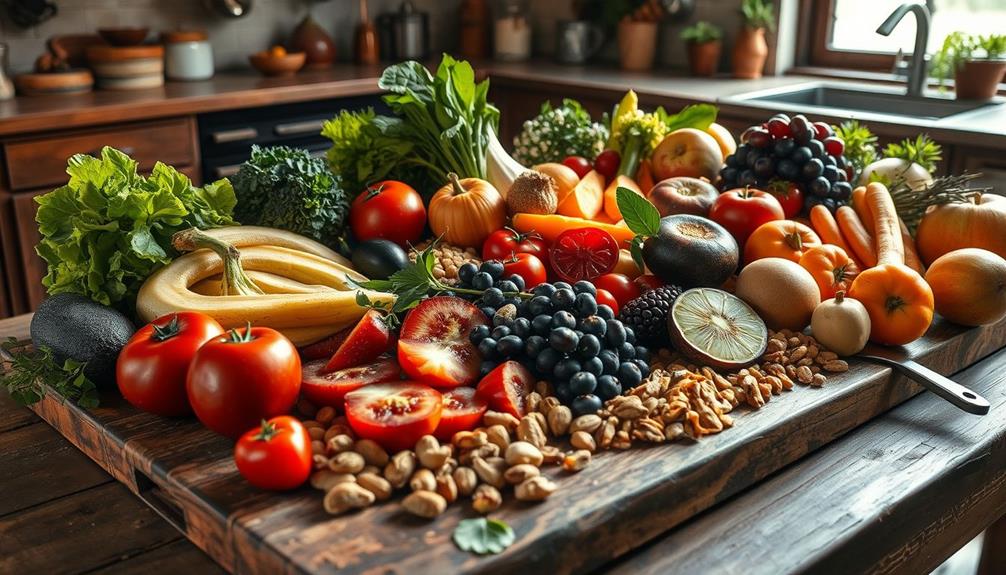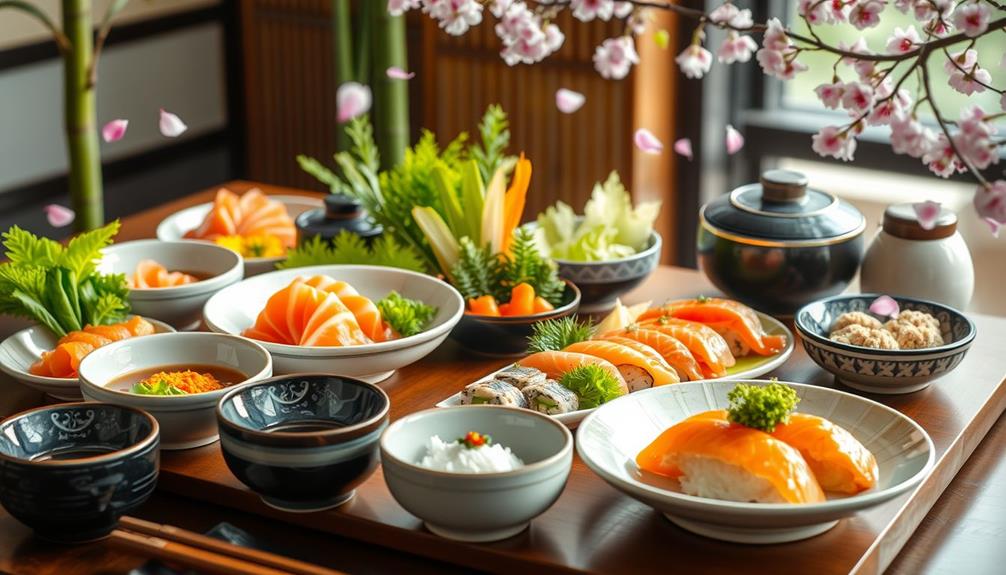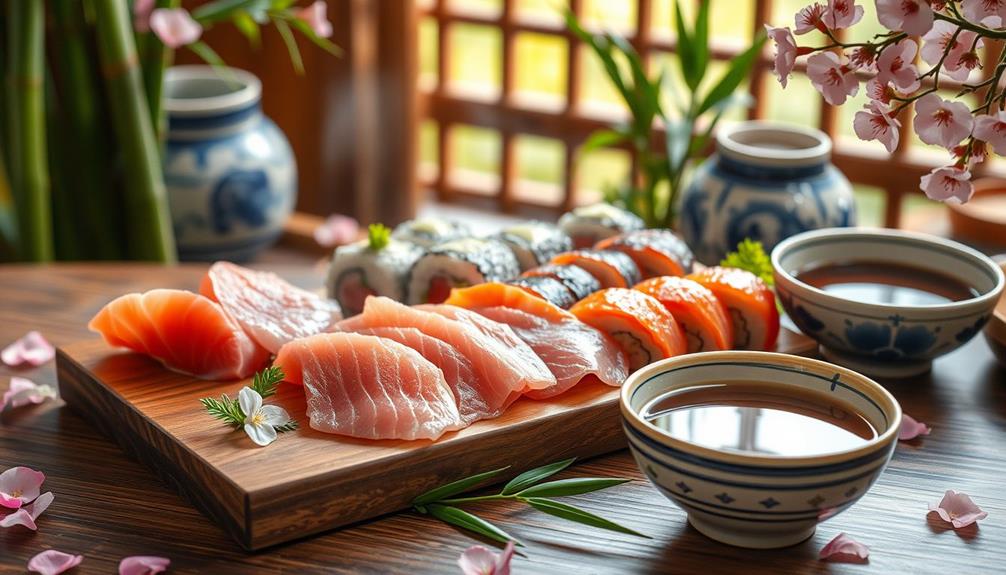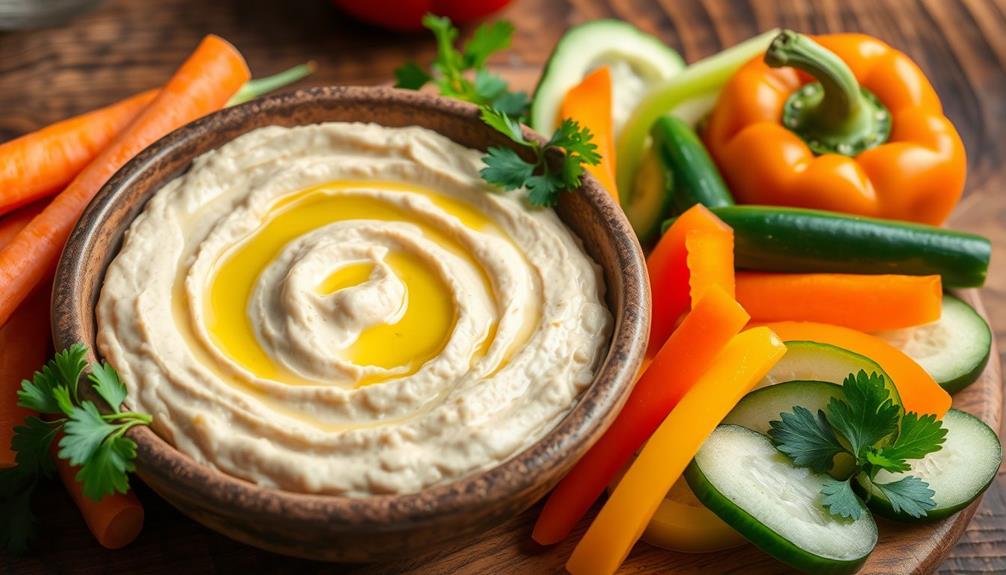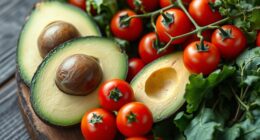Eating raw food can be safe and even healthy, but it demands careful attention to prevent nutritional deficiencies and foodborne illnesses. You'll enjoy benefits like increased nutrient intake, better digestion, and potential weight loss. However, you might miss out on essential nutrients like protein and vitamin B12, especially in strict raw vegan diets. It's also vital to practice safe food handling to avoid contamination, particularly with raw animal products. With mindful preparation and balanced meal choices, you can make raw foods work for you. Stick around to discover how to change smoothly and what other key considerations you should keep in mind.
Key Takeaways
- Raw food diets can be nutrient-dense but may lead to deficiencies in essential nutrients like vitamin B12 and protein if not carefully planned.
- Proper food safety practices are crucial, including washing produce and avoiding cross-contamination to minimize the risk of foodborne illnesses.
- Some nutrients, like lycopene in tomatoes, are more bioavailable when cooked, so a raw diet may miss certain health benefits.
- Long-term adherence to a raw food diet can increase the risk of health issues such as osteoporosis and cardiovascular problems due to limited food variety.
- Transitioning gradually to a raw food diet and monitoring body responses can help ensure essential nutrient requirements are met safely.
Overview of Raw Food Diets
The raw food diet's appeal lies in its emphasis on unprocessed, whole foods that promise to retain maximum nutrients and enzymes. This diet primarily includes raw fruits, vegetables, nuts, seeds, and sprouted grains, with food not heated beyond 104-118°F (40-48°C).
You might encounter various adaptations of raw food diets, such as raw vegan, which excludes all animal products, or raw vegetarian, allowing raw eggs and unprocessed dairy. Some even embrace a raw omnivorous approach, incorporating raw animal products.
Food preparation techniques play an important role in this diet. Juicing, blending, dehydrating, soaking, and sprouting enhance digestibility and nutritional value. Additionally, consuming certain foods like cranberry juice may offer benefits, though moderation is key due to potential gastrointestinal issues.
However, while you may find potential health benefits like increased energy and weight loss from raw food diets, it's vital to plan your meals carefully. Neglecting nutrient-rich foods can lead to deficiencies, particularly in protein, vitamin B12, iron, and omega-3 fatty acids.
Moreover, sticking to a raw food diet requires a significant commitment to meal preparation, making it a lifestyle choice that mightn't suit everyone. Those with certain health conditions should approach this diet with caution to avoid risks like foodborne illness.
Health Benefits of Raw Foods
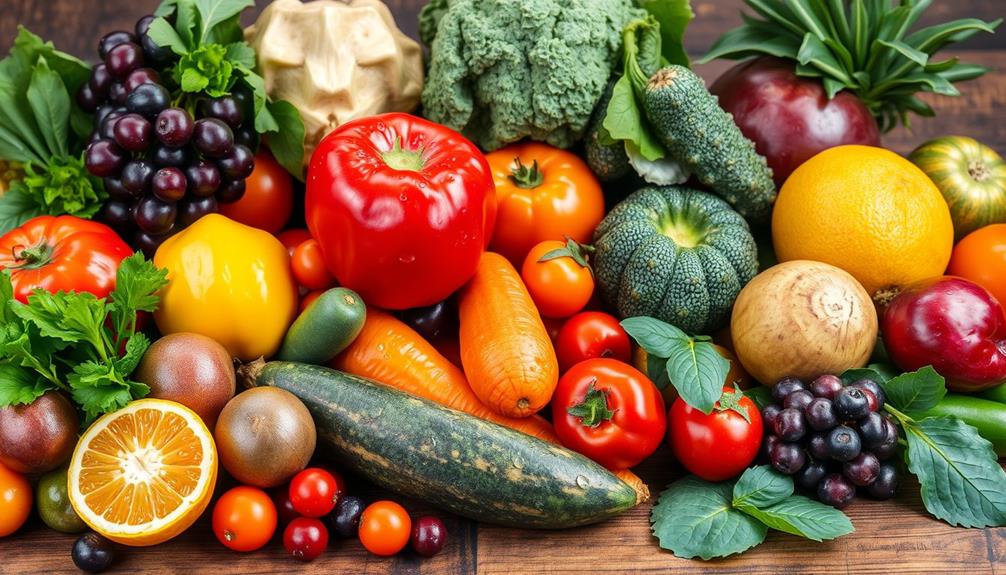
Eating a diet rich in raw foods can considerably boost your health and well-being. Raw foods, particularly fresh fruits and vegetables, are packed with nutrient density, offering essential vitamins, minerals, and antioxidants that support overall health.
Additionally, a raw food diet can enhance nutrient absorption due to minimal processing, leading to better utilization of these crucial nutrients. By incorporating more raw foods into your meals, you may notice lower cholesterol levels and reduced triglycerides, which can decrease your risk of heart disease.
Boost immune system function with the high vitamin and antioxidant levels found in raw foods.
A raw food diet is also known to enhance digestive health. The high fiber content in raw fruits and vegetables promotes satiety, making it easier for you to manage your weight and support weight loss efforts.
Furthermore, the natural enzymes preserved in raw foods can lead to improved digestion and increased energy levels.
Potential Risks and Safety Concerns
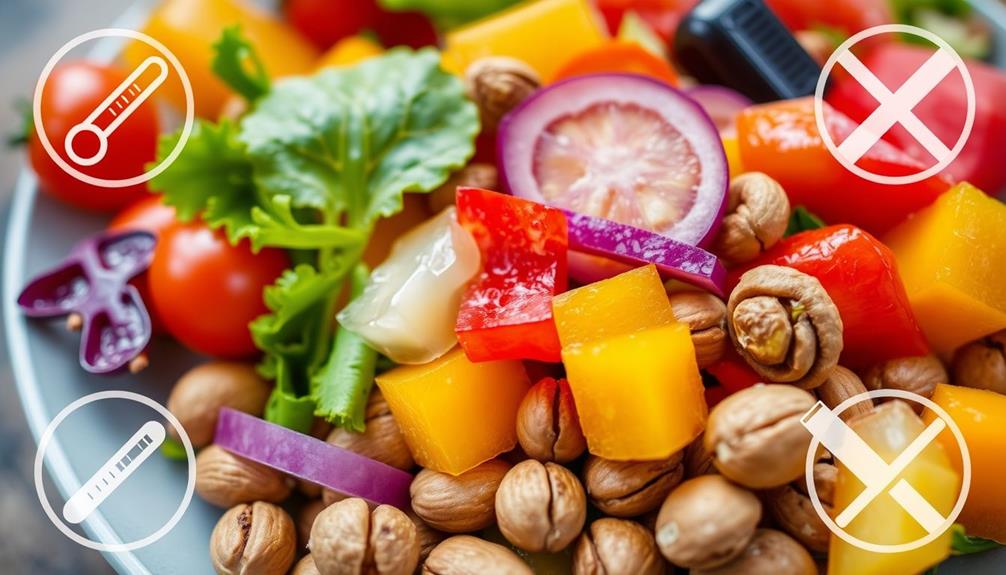
When opting for a raw food diet, it's vital to recognize the potential risks and safety concerns that come with it. Consuming raw animal products, like sushi and oysters, heightens your risk of foodborne illnesses caused by harmful bacteria such as Salmonella and E. coli.
Furthermore, some raw plant foods can pose serious health threats. It's crucial to understand the importance of early detection methods, just as mammography is essential for identifying breast cancer early, which can greatly improve treatment outcomes mammography aims to detect breast cancer early for better treatment outcomes.
Consider these key risks:
- Raw Animal Products: Increased chance of foodborne illnesses from contamination.
- Toxic Plant Foods: Certain items, like rhubarb leaves, contain natural toxins that can lead to severe health issues.
- Sprouted Seeds and Nuts: These can harbor bacteria, making them unsafe no matter how well you wash them.
- Cooking Necessities: Foods like kidney beans and cassava must be cooked to eliminate harmful natural toxins.
Individuals with compromised immune systems should be particularly cautious, as they're more susceptible to foodborne illnesses and complications.
Nutritional Considerations and Deficiencies
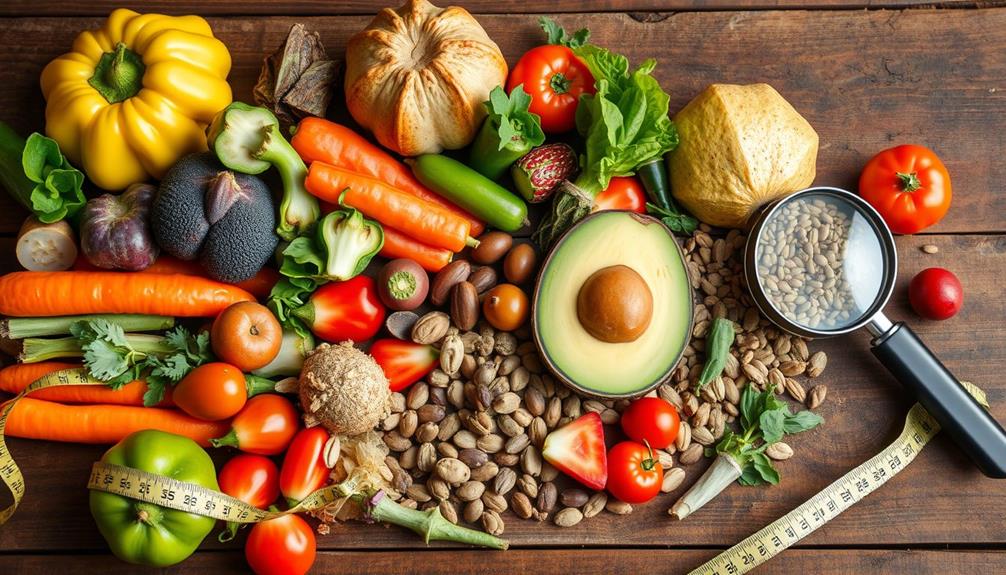
When you're on a raw food diet, you might miss out on essential nutrients like protein and vitamin B12, which are vital for your health.
This can lead to various financial mistakes to avoid in managing healthcare costs related to nutrient deficiencies.
Long-term adherence to this diet can increase your risk of serious health issues, including osteoporosis and cardiovascular problems.
It's important to plan your meals carefully and consider supplementation to avoid these deficiencies.
Essential Nutrient Deficiencies
A raw food diet's allure can often overshadow the potential for significant nutrient deficiencies that may arise. While you might enjoy the freshness of raw foods, be mindful that certain nutrients are harder to obtain.
Careful planning and knowledge about financial considerations for elderly care can be beneficial in guaranteeing your diet remains balanced. Here are four important deficiencies to reflect on:
- Vitamin B12: This necessary nutrient is primarily found in animal products, making it challenging for raw food dieters to get enough without supplementation.
- Calcium: Inadequate intake can lead to low bone mass and increase your risk of osteoporosis, especially if you're not consuming fortified foods.
- Omega-3 Fatty Acids: These are essential for heart and brain health; raw diets may lack sufficient sources like fish or flaxseeds.
- Nutrient Absorption: Cooking certain foods can enhance the bioavailability of nutrients; for instance, cooked tomatoes provide more lycopene, an important antioxidant.
Long-term adherence to a raw food diet could put you at risk for these deficiencies, so it's important to monitor your nutrient intake.
Regularly assess your diet to guarantee you're meeting your necessary nutrient needs for overall health and well-being.
Protein and Vitamin B12
Steering a raw food diet means paying close attention to your protein and vitamin B12 intake. Many plant-based sources lack sufficient protein and don't provide all vital amino acids, so you need to plan your meals carefully to guarantee adequate intake. Without enough protein, you risk facing deficiencies that can lead to serious health issues like muscle loss and anemia.
Additionally, it's important to evaluate the overall quality of your food choices, as some strong customer service and support can help guide you in selecting nutritious options.
Vitamin B12 is mainly found in animal products, making those on a raw vegan diet particularly vulnerable to deficiency. This vitamin is vital for red blood cell formation and neurological function, so you must monitor your levels closely. If you're not consuming fortified foods or supplements, you could develop neurological problems over time due to a lack of vitamin B12.
To stay on top of your nutritional status, evaluate regular blood tests. These can help you assess your protein and vitamin B12 levels, allowing for timely dietary adjustments or supplementation.
Long-term Health Risks
Long-term adherence to a raw food diet can pose significant health risks due to nutritional deficiencies. By limiting food variety and excluding animal products, you may experience several serious issues over time.
It's important to recognize how environmental interactions shape individual health outcomes, as seen in key domains of development in psychology. Here are four essential nutrient deficiencies to take into account:
- Vitamin B12: This necessary vitamin is primarily found in animal products, and its lack can lead to neurological issues and anemia.
- Calcium: Insufficient calcium intake can weaken your bones, increasing the risk of osteoporosis and fractures.
- Iron: Low iron levels can result in fatigue and decreased immune function, making you more susceptible to illness.
- Omega-3 Fatty Acids: These fats are fundamental for heart health, and their absence can raise your risk of cardiovascular diseases.
Moreover, inadequate caloric intake might lead to unintentional weight loss and muscle wasting, severely affecting your energy levels.
As a raw food dieter, you might need to supplement with vitamin D and other nutrients to prevent these deficiencies. Ultimately, while a raw food diet can be beneficial, it's essential to remain aware of these long-term health risks and take proactive steps to mitigate them.
Safe Preparation Techniques

When preparing raw foods, safety should always be your top priority. To guarantee you're following safe preparation techniques, start by washing all fruits and vegetables thoroughly under running water. This removes potential bacteria and pesticides that can lead to foodborne illnesses.
If you're soaking or sprouting beans and grains, maintain proper hygiene to prevent bacterial growth. Incorporating safe practices, such as avoiding high-sugar foods for pets, can also be beneficial for your health proper hamster care.
It's essential to use separate cutting boards for raw animal products and other foods. This practice helps you avoid cross-contamination, which can pose serious health risks. Regularly sanitize your surfaces to keep everything clean.
Additionally, be mindful of food temperature; keep it below 118°F during preparation. This preserves the nutrients and enzymes in your raw foods, while guaranteeing that any raw animal products come from reliable suppliers to minimize risks.
If you're consuming raw eggs or dairy, always opt for pasteurized varieties. This greatly reduces the risk of foodborne illnesses like Salmonella, which can be particularly harmful.
Popular Raw Food Trends
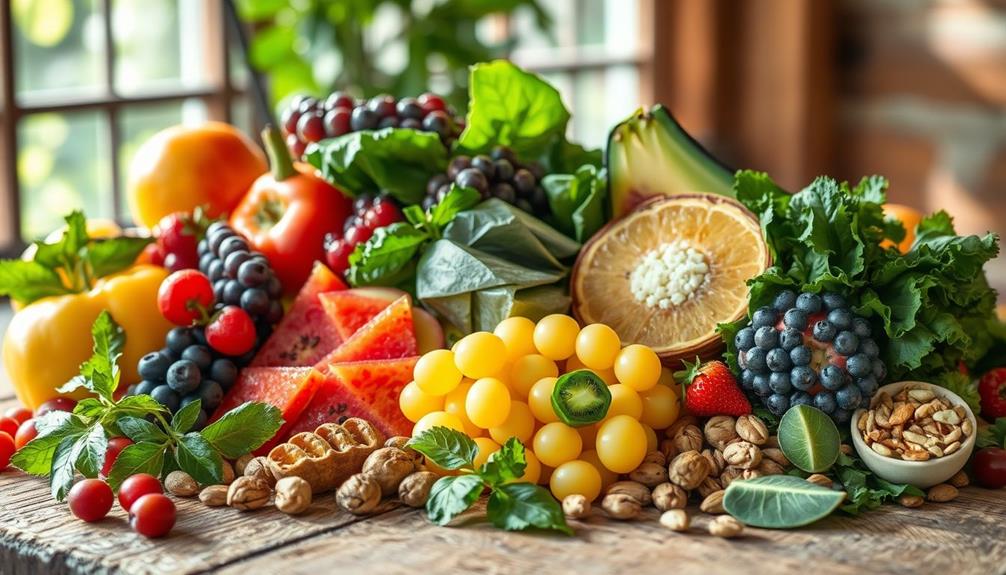
Raw food diets have become increasingly popular as more people seek healthier, unprocessed options. These diets emphasize whole foods like raw fruits, vegetables, nuts, seeds, and sprouted grains, while avoiding anything heated above 104-118°F.
Within this movement, several trends stand out, particularly focusing on plant-based foods and various dietary approaches. Many raw food enthusiasts also appreciate the brewing methods that maintain the integrity of ingredients, such as using cold-brew techniques for coffee.
Here are some popular raw food trends you might encounter:
- Raw Vegan: This strictly plant-based approach excludes all animal products, focusing solely on fruits, vegetables, nuts, and seeds.
- Juicing and Blending: Many enthusiasts blend or juice raw ingredients to create nutrient-dense beverages that retain natural enzymes and flavor.
- Dehydrating: This technique allows you to make snacks like raw crackers and fruit chips, which maintain their unprocessed state while providing variety.
- Raw Food Restaurants: A growing number of eateries cater to raw food diets, offering creative dishes that highlight the health benefits of unprocessed ingredients.
While these trends can promote increased energy and improved skin health, it's crucial to prioritize food safety to guarantee a positive experience with the raw food diet.
Tips for Transitioning to Raw Diet
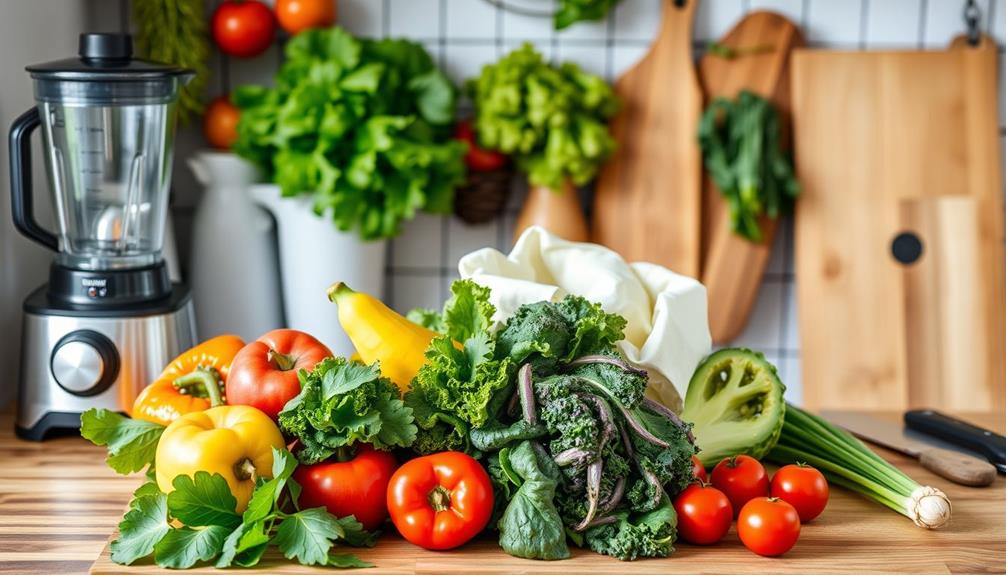
Changing to a raw diet doesn't have to be overwhelming; start slowly by adding more fresh fruits and veggies to your meals.
Incorporating a variety of foods beneficial for managing gout symptoms can also enhance your raw diet experience.
Gradually increase the proportion of raw ingredients while experimenting with simple recipes that excite your palate.
This approach helps you adjust comfortably and discover what works best for you.
Start Slowly, Gradually Increase
As you begin your journey to a raw food diet, starting slowly is essential for your body to adapt effectively. Shifting to eating raw foods can be a significant change, so take it step by step.
Here are some tips to help you gradually increase your raw food intake:
- Start with One Raw Meal: Incorporate one raw meal per day, like a smoothie or salad, to allow your body time to adjust.
- Focus on Whole Fruits and Vegetables: Begin with easily digestible whole raw fruits and vegetables to help curb cravings for cooked foods.
- Gradually Replace Cooked Meals: Over time, swap cooked meals for raw alternatives, adding nuts, seeds, and sprouted grains for extra nutrients and energy.
- Prioritize Hydration: Stay hydrated by drinking fresh juices or herbal teas, which can ease any initial digestive discomfort.
Throughout this shift, monitor your body's response and confirm you're meeting your essential nutrient requirements.
This careful approach will help you build a sustainable raw food lifestyle while maintaining your health.
Focus on Fresh Ingredients
Focusing on fresh ingredients is essential when you're progressing toward a raw food diet. Start by incorporating seasonal fruits and vegetables into your meals, as they're the cornerstone of this approach. Fresh produce provides crucial nutrients and fiber that boost your health and energy levels.
Investing in a high-quality blender or food processor can make your shift smoother. These tools help you prepare delicious smoothies, soups, and sauces while keeping your meals raw and nutritious.
Additionally, consider soaking and sprouting nuts, seeds, and grains. This process enhances their digestibility and increases their nutrient content, making your diet even healthier.
As you gradually increase the proportion of raw foods, your digestive system will adjust, which can help minimize any discomfort like gas or cramping.
Don't hesitate to seek support during this shift—join online communities or forums dedicated to raw food diets. These platforms can offer a wealth of recipes, tips, and encouragement to keep you motivated.
Experiment With Simple Recipes
Starting your journey into the raw food diet can be enjoyable and rewarding, especially when you experiment with simple recipes. Begin with easy-to-make dishes that incorporate raw ingredients like fruits, leafy greens, and nuts. This approach helps you ease into the lifestyle while ensuring you enjoy your meals.
Here are some tips to get started:
- Smoothies and Salads: Blend seasonal produce into smoothies or toss together salads filled with vibrant veggies for quick, healthy recipes.
- Invest in Tools: A high-quality blender and food processor can make a world of difference in preparing raw meals, simplifying your cooking process.
- Soaking and Sprouting: Experiment with soaking and sprouting nuts, seeds, and grains. This technique improves digestibility and boosts nutrient absorption, while adding texture to your dishes.
- Join Online Communities: Connect with others adapting to a raw food lifestyle through online communities or by following raw food blogs. You'll find inspiration, recipe ideas, and support.
Expert Opinions on Raw Foods
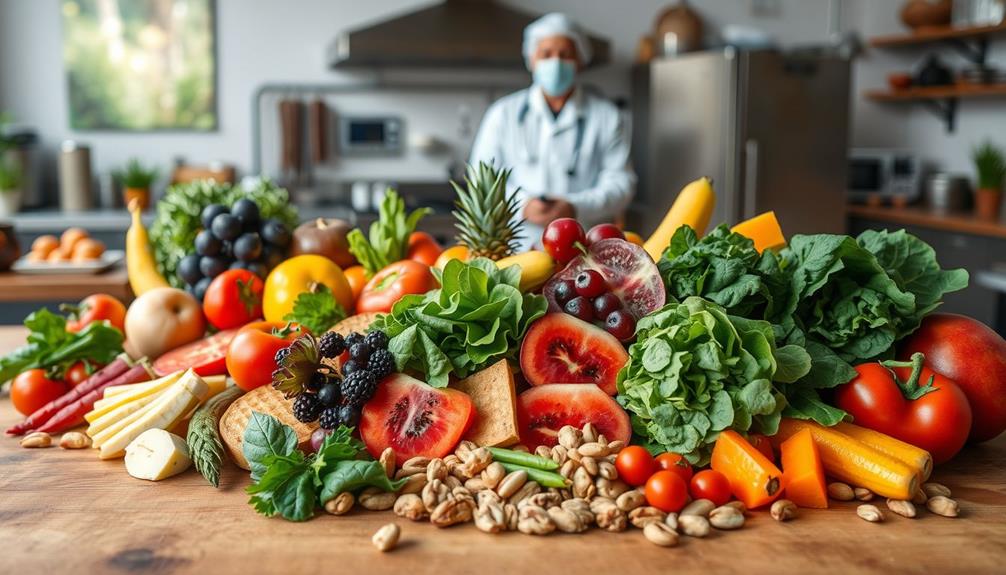
Many experts agree that while raw foods can offer significant nutritional benefits, they also come with notable safety concerns. A raw food diet can be rich in vitamins and minerals, but it's crucial to be aware of food safety risks. Bacterial contamination is a major concern, especially with raw animal products and certain plant foods like sprouts.
The American Dietetic Association stresses the importance of proper food handling to minimize the risk of foodborne illnesses, particularly with items such as raw eggs and unpasteurized dairy.
Research indicates that while some nutrients are abundant in raw foods, cooking can enhance nutrient absorption for specific vegetables. This means that a strictly raw food diet mightn't provide the best balance of vital nutrients.
Mixed health outcomes have been reported for individuals on raw food diets, showing benefits like weight loss and increased fruit and vegetable intake, but also risks of deficiencies in protein, vitamin B12, and other necessary vitamins.
Nutritionists often recommend careful planning and possibly supplementation to guarantee that a raw food diet can meet all nutritional needs, especially for vulnerable populations like pregnant women and the elderly.
Frequently Asked Questions
What Are the Risks of a Raw Food Diet?
A raw food diet can expose you to harmful bacteria, anti-nutrients, and potential nutrient deficiencies. If you're not careful with food selection and preparation, it might lead to digestive issues and serious health risks.
What Are the Rules for Raw Food?
Did you know that over 80% of raw food enthusiasts report improved energy levels? To follow raw food rules, focus on unheated foods, wash produce thoroughly, and consider nutrient balance to stay healthy and satisfied.
What Precautions Should Be Taken While Eating Raw Foods?
When eating raw foods, you should wash fruits and vegetables thoroughly, avoid raw animal products, and handle high-risk items carefully. Always use separate cutting boards for meats to prevent cross-contamination and guarantee kitchen cleanliness.
What Happens to Your Body When You Eat Raw Food?
When you eat raw food, your body absorbs more vitamins and enzymes, potentially improving digestion. However, you might experience gas or cramping as your system adjusts to higher fiber intake and different nutrient profiles.
Conclusion
To sum up, while a raw food diet can offer health benefits, it's crucial to be aware of the potential risks. For instance, imagine someone who switches to raw vegetables and fruits but neglects protein sources. They might feel great initially but later face fatigue and nutrient deficiencies. By taking proper precautions, like ensuring a balanced intake and practicing safe food prep, you can enjoy the benefits of raw foods without compromising your health.

